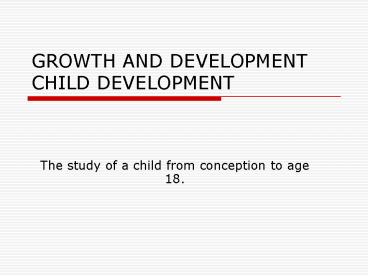GROWTH AND DEVELOPMENT CHILD DEVELOPMENT PowerPoint PPT Presentation
1 / 19
Title: GROWTH AND DEVELOPMENT CHILD DEVELOPMENT
1
GROWTH AND DEVELOPMENTCHILD DEVELOPMENT
- The study of a child from conception to age 18.
2
The five stages of development are
- Infancy--birth to 12 months.
- Toddler--12 months to 3 years.
- Preschool--3 years to 6 years
- School age--6 years to 12 years.
- Adolescents--13 years to 18 years
3
GROWTH
- A child's physical increase in size or amount
that is easily observed.
4
DEVELOPMENT
- The ability of a child to do things that are
complex and difficult.
5
LAWS OF GROWTH AND DEVELOPMENT
- 1. Growth proceeds from head to foot
(cephalohead, caudaltail)--lift head, pick up
objects, walk to objects.2. Growth proceeds from
near to far (proximal-distal)--from body trunk
outward, scoot body, wave arms, grab object, and
pick up object.
6
- 3. Growth proceeds from the simple to the
complex--sleeping, being fed, holding the
bottle, feeding self.4. Growth is continuous and
orderly--both legs grow at the same time and
rate.
7
GENERALIZATIONS OF GROWTH AND DEVELOPMENT
- 1. The tempo of growth is not even.
- Different aspects of growth develop at different
rates. - Both the rate and pattern of growth can be
modified by conditions within andoutside of the
body.
8
- 4. Each child grows in his/her own unique way.5.
Every individual normally passes through every
stage of development.6. Growth is complex. All
of its aspects are closely interrelated.7.
Growth is predictable since individual
differences remain constant.
9
- 8. Growth proceeds from the general to the
specific.9. Each developmental phase has
characteristic traits.10. Many forms of problem
behavior are normal due to the age in which they
occur.
10
- 11. Most traits in development are
correlated.12. Behavior is caused.
11
- 13. The impulse to use the capacity or power
in an exaggerated way is associated with the
development of a capacity or power.14. Learning
must wait on maturation.15. Whenever an act
results in a feeling of satisfaction to an
individual, the act is likely to be
repeated.16. Children's concepts grow out of
their experiences.
12
- 17. Experimentation is an important part of
learning. - 18. The urge to grow is innate.
13
Areas of Development
- 1. PHYSICAL DEVELOPMENTIncludes muscle
coordination and control, growth in size and in
proportion. Examples a child rolling over,
lifting its head, or sitting up.
14
2. COGNITIVE DEVELOPMENT
- The ability of the brain or mind to take in
and process information. Examples a child
recognizing their name, or recognizing a parent,
recognizing that when they shake a rattle it will
make a noise.
15
3. SOCIAL DEVELOPMENT
- A child learning and discovering the
expectations and rules for interacting with
others. Examples a child smiling at mother, a
child learning to share a toy with a friend.
16
4. EMOTIONAL DEVELOPMENT
- The ability to recognize and understand
feelings and how to respond to them
appropriately. Example a child feeling jealousy
due to a new baby in the family, a child feeling
love for another person, a child being afraid of
the dark.
17
5. MORAL DEVELOPMENT
- Identifying personal values. Examples right
or wrong, behaving according to what others need
or want, respecting human rights, developing
principles to guide behavior.
18
Why do we observe of Children?
- To gain a deeper understanding of children, in
general how they think and feel, how they can be
expected to grow and behave. - To get to know a specific child better -- the
child's needs interests, skills, problems, and
feelings.
19
- To assess where a child is developmentally and
make comparisons with other children that same
age - To identify special needs, problems, or interests
children may have.

